Development of Peptidomimetic Inhibitors of the ERG Gene Fusion Product in Prostate Cancer
- PMID: 28344039
- PMCID: PMC5443258
- DOI: 10.1016/j.ccell.2017.02.017
Development of Peptidomimetic Inhibitors of the ERG Gene Fusion Product in Prostate Cancer
Erratum in
-
Development of Peptidomimetic Inhibitors of the ERG Gene Fusion Product in Prostate Cancer.Cancer Cell. 2017 Jun 12;31(6):844-847. doi: 10.1016/j.ccell.2017.05.001. Cancer Cell. 2017. PMID: 28609659 No abstract available.
-
Development of Peptidomimetic Inhibitors of the ERG Gene Fusion Product in Prostate Cancer.Cancer Cell. 2024 Aug 12;42(8):1471. doi: 10.1016/j.ccell.2024.07.009. Cancer Cell. 2024. PMID: 39137731 Free PMC article. No abstract available.
Abstract
Transcription factors play a key role in the development of diverse cancers, and therapeutically targeting them has remained a challenge. In prostate cancer, the gene encoding the transcription factor ERG is recurrently rearranged and plays a critical role in prostate oncogenesis. Here, we identified a series of peptides that interact specifically with the DNA binding domain of ERG. ERG inhibitory peptides (EIPs) and derived peptidomimetics bound ERG with high affinity and specificity, leading to proteolytic degradation of the ERG protein. The EIPs attenuated ERG-mediated transcription, chromatin recruitment, protein-protein interactions, cell invasion and proliferation, and tumor growth. Thus, peptidomimetic targeting of transcription factor fusion products may provide a promising therapeutic strategy for prostate cancer as well as other malignancies.
Keywords: ERG transcription factor; peptidomimetic inhibitor; prostate cancer.
Copyright © 2017 Elsevier Inc. All rights reserved.
Figures
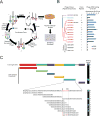
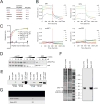
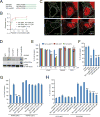
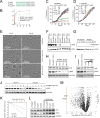
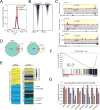

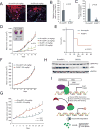
Comment in
-
Prostate cancer: Peptidomimetics have potential.Nat Rev Urol. 2017 Jun;14(6):328. doi: 10.1038/nrurol.2017.59. Epub 2017 Apr 11. Nat Rev Urol. 2017. PMID: 28401956 No abstract available.
Similar articles
-
Identification of a Small Molecule That Selectively Inhibits ERG-Positive Cancer Cell Growth.Cancer Res. 2018 Jul 1;78(13):3659-3671. doi: 10.1158/0008-5472.CAN-17-2949. Epub 2018 Apr 30. Cancer Res. 2018. PMID: 29712692
-
Discovery and characterization of small molecules targeting the DNA-binding ETS domain of ERG in prostate cancer.Oncotarget. 2017 Jun 27;8(26):42438-42454. doi: 10.18632/oncotarget.17124. Oncotarget. 2017. PMID: 28465491 Free PMC article.
-
Binding of TMPRSS2-ERG to BAF Chromatin Remodeling Complexes Mediates Prostate Oncogenesis.Mol Cell. 2018 Aug 16;71(4):554-566.e7. doi: 10.1016/j.molcel.2018.06.040. Epub 2018 Aug 2. Mol Cell. 2018. PMID: 30078722 Free PMC article.
-
The Expression of Proto-Oncogene ETS-Related Gene (ERG) Plays a Central Role in the Oncogenic Mechanism Involved in the Development and Progression of Prostate Cancer.Int J Mol Sci. 2022 Apr 26;23(9):4772. doi: 10.3390/ijms23094772. Int J Mol Sci. 2022. PMID: 35563163 Free PMC article. Review.
-
The oncogene ERG: a key factor in prostate cancer.Oncogene. 2016 Jan 28;35(4):403-14. doi: 10.1038/onc.2015.109. Epub 2015 Apr 27. Oncogene. 2016. PMID: 25915839 Review.
Cited by
-
A Drosophila model of oral peptide therapeutics for adult intestinal stem cell tumors.Dis Model Mech. 2020 Jul 23;13(7):dmm044420. doi: 10.1242/dmm.044420. Dis Model Mech. 2020. PMID: 32540914 Free PMC article.
-
Mapping Isoform Abundance and Interactome of the Endogenous TMPRSS2-ERG Fusion Protein by Orthogonal Immunoprecipitation-Mass Spectrometry Assays.Mol Cell Proteomics. 2021;20:100075. doi: 10.1016/j.mcpro.2021.100075. Epub 2021 Mar 23. Mol Cell Proteomics. 2021. PMID: 33771697 Free PMC article.
-
Capicua regulates neural stem cell proliferation and lineage specification through control of Ets factors.Nat Commun. 2019 May 1;10(1):2000. doi: 10.1038/s41467-019-09949-6. Nat Commun. 2019. PMID: 31043608 Free PMC article.
-
Calcium and Nuclear Signaling in Prostate Cancer.Int J Mol Sci. 2018 Apr 19;19(4):1237. doi: 10.3390/ijms19041237. Int J Mol Sci. 2018. PMID: 29671777 Free PMC article. Review.
-
Fusions in solid tumours: diagnostic strategies, targeted therapy, and acquired resistance.Nat Rev Clin Oncol. 2017 Dec;14(12):735-748. doi: 10.1038/nrclinonc.2017.127. Epub 2017 Aug 31. Nat Rev Clin Oncol. 2017. PMID: 28857077 Free PMC article. Review.
References
-
- Albihn A, Johnsen JI, Henriksson MA. MYC in oncogenesis and as a target for cancer therapies. Adv Cancer Res. 2010;107:163–224. - PubMed
-
- An J, Ren S, Murphy SJ, Dalangood S, Chang C, Pang X, Cui Y, Wang L, Pan Y, Zhang X, et al. Truncated ERG Oncoproteins from TMPRSS2-ERG Fusions Are Resistant to SPOP-Mediated Proteasome Degradation. Molecular cell. 2015;59:904–916. - PubMed
-
- Attard G, Swennenhuis JF, Olmos D, Reid AH, Vickers E, A’Hern R, Levink R, Coumans F, Moreira J, Riisnaes R, et al. Characterization of ERG, AR and PTEN gene status in circulating tumor cells from patients with castration-resistant prostate cancer. Cancer Res. 2009;69:2912–2918. - PubMed
Publication types
MeSH terms
Substances
Grants and funding
LinkOut - more resources
Full Text Sources
Other Literature Sources
Medical
Molecular Biology Databases
Miscellaneous

